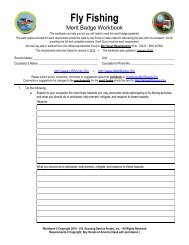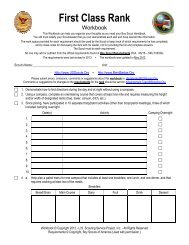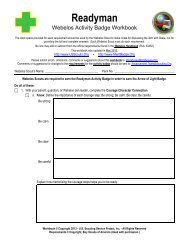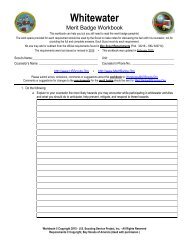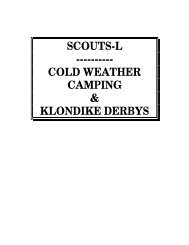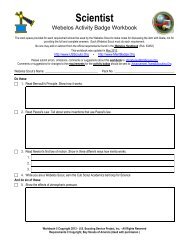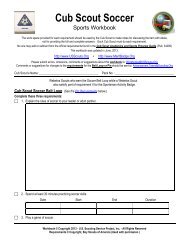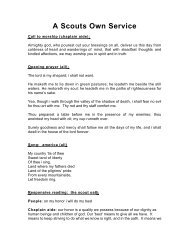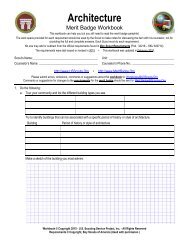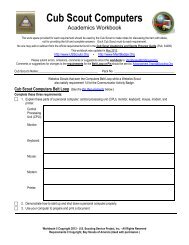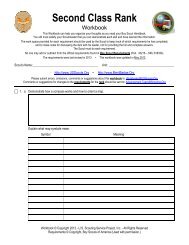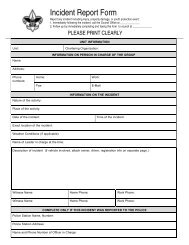BALOO'S BUGLE - US Scouting Service Project
BALOO'S BUGLE - US Scouting Service Project
BALOO'S BUGLE - US Scouting Service Project
Create successful ePaper yourself
Turn your PDF publications into a flip-book with our unique Google optimized e-Paper software.
<strong>BALOO'S</strong> <strong>BUGLE</strong> Page 5Category 1: wind speeds 74-95 mphCategory 2: wind speeds 96-110 mphCategory 3: wind speeds 111-130 mphCategory 4: wind speeds 131-155 mphCategory 5: wind speeds over 155 mphSeasons:Severe Thunderstorm:Severe Weather:Showers:Shear:Sleet:Snow:Snow Flurries:Snow Showers:Snowflakes:Sprinkle:Squall Line:Stable Air:The earth's position in relation to the sun is always changing. The earth spins around its axis, animaginary line that runs between the north and south poles. One complete spin takes 24 hours, and at anymoment, half of the earth is lit and warm (day), while the other half faces away from the sun (night).While it spins the earth also moves around the sun in a circle, called an orbit, and the orbit takes oneyear to complete. As the earth moves and spins it is tilted in one direction at an angle of 23 degrees. Itstays tilted all the time as it orbits the sun so that each area of earth receives different amounts of thesun's energy at different times of the year. This is why we have seasons.A thunderstorm with winds of 58 mph or greater and/or with hail ¾ inch in diameter or larger.Any kind of destructive or life-threatening weather event. Thunderstorms can be destructive,while tornadoes, high winds, hail, excessive rainfall and lightning can be life threatening.Rain falling from the sky causing puddles to form on the ground.A variation in the wind speed and/or direction over a short distance.Solid precipitation in the form of ice pellets form when raindrops, originating in warmer air aloft, freezeas they fall through subfreezing air near the surface of the Earth.Precipitation that is composed of white ice crystals that fall from clouds. Snow may stick together toform snowflakes, which have a hexagonal or six-sided shape.Brief occurrences of very light snow, which produce little or no accumulation.Brief occurrences of light to moderate snow, which could produce some snowfall accumulations.Packets of falling snow formed when at least a few ice crystals are matted together. The largestsnowflakes tend to occur when temperatures are near freezing. Snowflakes have a hexagonal or six-sidedshape.A very light shower of rain just barely wetting the ground.A line of thunderstorms sometimes several hundred miles long that can produce strong thunderstormsand sometimes severe weather.Air that is colder than its surroundings and is resistant to upward movement.Stationary Front: A boundary between two air masses that more or less doesn’t move, but some stationary fronts canwobble back and forth for several hundred miles a day.Storm:Stratus Clouds:Supercell:Temperature:Thermometer:Thunder:Thunderstorm:Tidal Wave:Tornado:Any disturbed state of the atmosphere that creates unpleasant weather like rain, lightning, thunder, hail,snow, sleet, and freezing rain.Low-lying, gray and sheetlike clouds that often produce drizzle. Stratus clouds are a principal cloud type.A severe thunderstorm whose updrafts and downdrafts are in near balance for several hours. Supercellsoften produce large hail and tornadoes.The measurement of how hot or cold something is.The instrument that measures temperature.The explosive sound of air expanding as it is heated by lightning.A storm produced by a cumulonimbus cloud and always has lightning and thunder. Rain, hail and high windsmay or may not occur.A destructive and high rise of water along a seashore. Tidal waves are caused by underwaterearthquakes, volcanoes or landslides, and have nothing to do with tides.Begins as a funnel cloud with spinning columns of air that drop down from a severe thunderstorm. Whenthey reach the ground they become tornadoes. Tornadoes are between 300 and 2,000 feet wide andtravel at speeds of 20 to 45 miles per hour. They usually only last a few minutes, but their spinning winds,up to 300 miles per hour, can lift houses into the air and rip trees from the ground.



